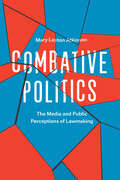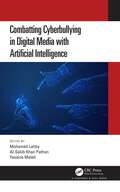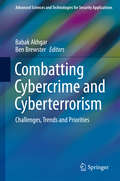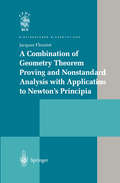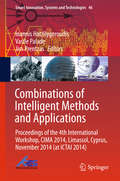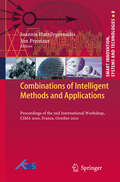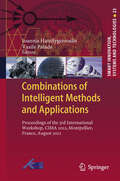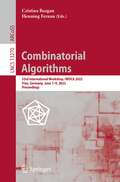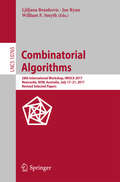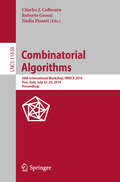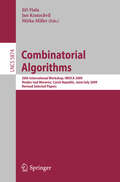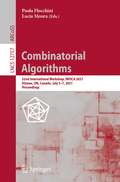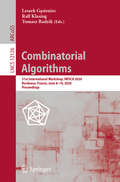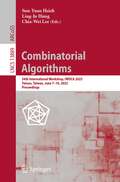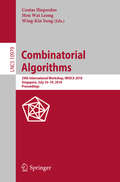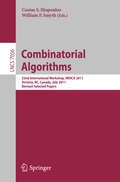- Table View
- List View
Combating Online Hostile Posts in Regional Languages during Emergency Situation: First International Workshop, CONSTRAINT 2021, Collocated with AAAI 2021, Virtual Event, February 8, 2021, Revised Selected Papers (Communications in Computer and Information Science #1402)
by Tanmoy Chakraborty Kai Shu H. Russell Bernard Huan Liu Md Shad AkhtarThis book constitutes selected and revised papers from the First International Workshop on Combating Online Hostile Posts in Regional Languages during Emergency Situation, CONSTRAINT 2021, Collocated with AAAI 2021, held as virtual event, in February 2021. The 14 full papers and 9 short papers presented were thoroughly reviewed and selected from 62 qualified submissions. The papers present interdisciplinary approaches on multilingual social media analytics and non-conventional ways of combating online hostile posts.
Combating Security Challenges in the Age of Big Data: Powered by State-of-the-Art Artificial Intelligence Techniques (Advanced Sciences and Technologies for Security Applications)
by Zubair Md. Fadlullah Al-Sakib Khan PathanThis book addresses the key security challenges in the big data centric computing and network systems, and discusses how to tackle them using a mix of conventional and state-of-the-art techniques. The incentive for joining big data and advanced analytics is no longer in doubt for businesses and ordinary users alike. Technology giants like Google, Microsoft, Amazon, Facebook, Apple, and companies like Uber, Airbnb, NVIDIA, Expedia, and so forth are continuing to explore new ways to collect and analyze big data to provide their customers with interactive services and new experiences. With any discussion of big data, security is not, however, far behind. Large scale data breaches and privacy leaks at governmental and financial institutions, social platforms, power grids, and so forth, are on the rise that cost billions of dollars. The book explains how the security needs and implementations are inherently different at different stages of the big data centric system, namely at the point of big data sensing and collection, delivery over existing networks, and analytics at the data centers. Thus, the book sheds light on how conventional security provisioning techniques like authentication and encryption need to scale well with all the stages of the big data centric system to effectively combat security threats and vulnerabilities. The book also uncovers the state-of-the-art technologies like deep learning and blockchain which can dramatically change the security landscape in the big data era.
Combating Spyware in the Enterprise: Discover, Detect, and Eradicate the Internet's Greatest Threat
by Paul PiccardCombating Spyware in the Enterprise is the first book published on defending enterprise networks from increasingly sophisticated and malicious spyware.Combating Spyware in the Enterprise begins by examining the various types of insidious spyware and adware currently propagating across the internet and infiltrating enterprise networks. This section closely examines Spyware's ongoing transformation from nuisance to malicious, sophisticated attack vector. Next, the book uncovers spyware's intricate economy and network of malicious hackers and criminals. Forensic investigations presented in this section of the book reveal how increasingly sophisticated spyware can compromise enterprise networks via trojans, keystroke loggers, system monitoring, distributed denial of service attacks, backdoors, viruses, and worms. After close examination of these attack vectors, the book begins to detail both manual and automated techniques for scanning your network for the presence of spyware, and customizing your IDS and IPS to detect spyware. From here, the book goes on to detail how to prevent spyware from being initially installed to mitigating the damage inflicted by spyware should your network become infected. Techniques discussed in this section include slowing the exposure rate; web filtering; using FireFox, MacOSX, or Linux; patching and updating, machine restrictions, shielding, deploying anti-spyware, and re-imaging. The book concludes with an analysis of the future of spyware and what the security community must accomplish to win the ware against spyware.* A recent survey published by Information Security Magazine stated that "combating spyare" was the #2 priority for security professionals in 2005* Despite the high priority placed on combating spyware by security professionals, there are no other books published or announced that address this market * Author Paul Piccard is Director of Research for Webroot, which is a market leader for pure-play anti-spyware vendors
Combative Politics: The Media and Public Perceptions of Lawmaking
by Mary Layton AtkinsonFrom the Affordable Care Act to No Child Left Behind, politicians often face a puzzling problem: although most Americans support the aims and key provisions of these policies, they oppose the bills themselves. How can this be? Why does the American public so often reject policies that seem to offer them exactly what they want? By the time a bill is pushed through Congress or ultimately defeated, we’ve often been exposed to weeks, months—even years—of media coverage that underscores the unpopular process of policymaking, and Mary Layton Atkinson argues that this leads us to reject the bill itself. Contrary to many Americans’ understandings of the policymaking process, the best answer to a complex problem is rarely self-evident, and politicians must weigh many potential options, each with merits and drawbacks. As the public awaits a resolution, the news media tend to focus not on the substance of the debate but on descriptions of partisan combat. This coverage leads the public to believe everyone in Washington has lost sight of the problem altogether and is merely pursuing policies designed for individual political gain. Politicians in turn exacerbate the problem when they focus their objections to proposed policies on the lawmaking process, claiming, for example, that a bill is being pushed through Congress with maneuvers designed to limit minority party input. These negative portrayals become linked in many people’s minds with the policy itself, leading to backlash against bills that may otherwise be seen as widely beneficial. Atkinson argues that journalists and educators can make changes to help inoculate Americans against the idea that debate always signifies dysfunction in the government. Journalists should strive to better connect information about policy provisions to the problems they are designed to ameliorate. Educators should stress that although debate sometimes serves political interests, it also offers citizens a window onto the lawmaking process that can help them evaluate the work their government is doing.
Combative Politics: The Media and Public Perceptions of Lawmaking
by Mary Layton AtkinsonFrom the Affordable Care Act to No Child Left Behind, politicians often face a puzzling problem: although most Americans support the aims and key provisions of these policies, they oppose the bills themselves. How can this be? Why does the American public so often reject policies that seem to offer them exactly what they want? By the time a bill is pushed through Congress or ultimately defeated, we’ve often been exposed to weeks, months—even years—of media coverage that underscores the unpopular process of policymaking, and Mary Layton Atkinson argues that this leads us to reject the bill itself. Contrary to many Americans’ understandings of the policymaking process, the best answer to a complex problem is rarely self-evident, and politicians must weigh many potential options, each with merits and drawbacks. As the public awaits a resolution, the news media tend to focus not on the substance of the debate but on descriptions of partisan combat. This coverage leads the public to believe everyone in Washington has lost sight of the problem altogether and is merely pursuing policies designed for individual political gain. Politicians in turn exacerbate the problem when they focus their objections to proposed policies on the lawmaking process, claiming, for example, that a bill is being pushed through Congress with maneuvers designed to limit minority party input. These negative portrayals become linked in many people’s minds with the policy itself, leading to backlash against bills that may otherwise be seen as widely beneficial. Atkinson argues that journalists and educators can make changes to help inoculate Americans against the idea that debate always signifies dysfunction in the government. Journalists should strive to better connect information about policy provisions to the problems they are designed to ameliorate. Educators should stress that although debate sometimes serves political interests, it also offers citizens a window onto the lawmaking process that can help them evaluate the work their government is doing.
Combative Politics: The Media and Public Perceptions of Lawmaking
by Mary Layton AtkinsonFrom the Affordable Care Act to No Child Left Behind, politicians often face a puzzling problem: although most Americans support the aims and key provisions of these policies, they oppose the bills themselves. How can this be? Why does the American public so often reject policies that seem to offer them exactly what they want? By the time a bill is pushed through Congress or ultimately defeated, we’ve often been exposed to weeks, months—even years—of media coverage that underscores the unpopular process of policymaking, and Mary Layton Atkinson argues that this leads us to reject the bill itself. Contrary to many Americans’ understandings of the policymaking process, the best answer to a complex problem is rarely self-evident, and politicians must weigh many potential options, each with merits and drawbacks. As the public awaits a resolution, the news media tend to focus not on the substance of the debate but on descriptions of partisan combat. This coverage leads the public to believe everyone in Washington has lost sight of the problem altogether and is merely pursuing policies designed for individual political gain. Politicians in turn exacerbate the problem when they focus their objections to proposed policies on the lawmaking process, claiming, for example, that a bill is being pushed through Congress with maneuvers designed to limit minority party input. These negative portrayals become linked in many people’s minds with the policy itself, leading to backlash against bills that may otherwise be seen as widely beneficial. Atkinson argues that journalists and educators can make changes to help inoculate Americans against the idea that debate always signifies dysfunction in the government. Journalists should strive to better connect information about policy provisions to the problems they are designed to ameliorate. Educators should stress that although debate sometimes serves political interests, it also offers citizens a window onto the lawmaking process that can help them evaluate the work their government is doing.
Combative Politics: The Media and Public Perceptions of Lawmaking
by Mary Layton AtkinsonFrom the Affordable Care Act to No Child Left Behind, politicians often face a puzzling problem: although most Americans support the aims and key provisions of these policies, they oppose the bills themselves. How can this be? Why does the American public so often reject policies that seem to offer them exactly what they want? By the time a bill is pushed through Congress or ultimately defeated, we’ve often been exposed to weeks, months—even years—of media coverage that underscores the unpopular process of policymaking, and Mary Layton Atkinson argues that this leads us to reject the bill itself. Contrary to many Americans’ understandings of the policymaking process, the best answer to a complex problem is rarely self-evident, and politicians must weigh many potential options, each with merits and drawbacks. As the public awaits a resolution, the news media tend to focus not on the substance of the debate but on descriptions of partisan combat. This coverage leads the public to believe everyone in Washington has lost sight of the problem altogether and is merely pursuing policies designed for individual political gain. Politicians in turn exacerbate the problem when they focus their objections to proposed policies on the lawmaking process, claiming, for example, that a bill is being pushed through Congress with maneuvers designed to limit minority party input. These negative portrayals become linked in many people’s minds with the policy itself, leading to backlash against bills that may otherwise be seen as widely beneficial. Atkinson argues that journalists and educators can make changes to help inoculate Americans against the idea that debate always signifies dysfunction in the government. Journalists should strive to better connect information about policy provisions to the problems they are designed to ameliorate. Educators should stress that although debate sometimes serves political interests, it also offers citizens a window onto the lawmaking process that can help them evaluate the work their government is doing.
Combative Politics: The Media and Public Perceptions of Lawmaking
by Mary Layton AtkinsonFrom the Affordable Care Act to No Child Left Behind, politicians often face a puzzling problem: although most Americans support the aims and key provisions of these policies, they oppose the bills themselves. How can this be? Why does the American public so often reject policies that seem to offer them exactly what they want? By the time a bill is pushed through Congress or ultimately defeated, we’ve often been exposed to weeks, months—even years—of media coverage that underscores the unpopular process of policymaking, and Mary Layton Atkinson argues that this leads us to reject the bill itself. Contrary to many Americans’ understandings of the policymaking process, the best answer to a complex problem is rarely self-evident, and politicians must weigh many potential options, each with merits and drawbacks. As the public awaits a resolution, the news media tend to focus not on the substance of the debate but on descriptions of partisan combat. This coverage leads the public to believe everyone in Washington has lost sight of the problem altogether and is merely pursuing policies designed for individual political gain. Politicians in turn exacerbate the problem when they focus their objections to proposed policies on the lawmaking process, claiming, for example, that a bill is being pushed through Congress with maneuvers designed to limit minority party input. These negative portrayals become linked in many people’s minds with the policy itself, leading to backlash against bills that may otherwise be seen as widely beneficial. Atkinson argues that journalists and educators can make changes to help inoculate Americans against the idea that debate always signifies dysfunction in the government. Journalists should strive to better connect information about policy provisions to the problems they are designed to ameliorate. Educators should stress that although debate sometimes serves political interests, it also offers citizens a window onto the lawmaking process that can help them evaluate the work their government is doing.
Combative Politics: The Media and Public Perceptions of Lawmaking
by Mary Layton AtkinsonFrom the Affordable Care Act to No Child Left Behind, politicians often face a puzzling problem: although most Americans support the aims and key provisions of these policies, they oppose the bills themselves. How can this be? Why does the American public so often reject policies that seem to offer them exactly what they want? By the time a bill is pushed through Congress or ultimately defeated, we’ve often been exposed to weeks, months—even years—of media coverage that underscores the unpopular process of policymaking, and Mary Layton Atkinson argues that this leads us to reject the bill itself. Contrary to many Americans’ understandings of the policymaking process, the best answer to a complex problem is rarely self-evident, and politicians must weigh many potential options, each with merits and drawbacks. As the public awaits a resolution, the news media tend to focus not on the substance of the debate but on descriptions of partisan combat. This coverage leads the public to believe everyone in Washington has lost sight of the problem altogether and is merely pursuing policies designed for individual political gain. Politicians in turn exacerbate the problem when they focus their objections to proposed policies on the lawmaking process, claiming, for example, that a bill is being pushed through Congress with maneuvers designed to limit minority party input. These negative portrayals become linked in many people’s minds with the policy itself, leading to backlash against bills that may otherwise be seen as widely beneficial. Atkinson argues that journalists and educators can make changes to help inoculate Americans against the idea that debate always signifies dysfunction in the government. Journalists should strive to better connect information about policy provisions to the problems they are designed to ameliorate. Educators should stress that although debate sometimes serves political interests, it also offers citizens a window onto the lawmaking process that can help them evaluate the work their government is doing.
Combatting Cyberbullying in Digital Media with Artificial Intelligence
by Mohamed LahbyRapid advancements in mobile computing and communication technology and recent technological progress have opened up a plethora of opportunities. These advancements have expanded knowledge, facilitated global business, enhanced collaboration, and connected people through various digital media platforms. While these virtual platforms have provided new avenues for communication and self-expression, they also pose significant threats to our privacy. As a result, we must remain vigilant against the propagation of electronic violence through social networks. Cyberbullying has emerged as a particularly concerning form of online harassment and bullying, with instances of racism, terrorism, and various types of trolling becoming increasingly prevalent worldwide. Addressing the issue of cyberbullying to find effective solutions is a challenge for the web mining community, particularly within the realm of social media. In this context, artificial intelligence (AI) can serve as a valuable tool in combating the diverse manifestations of cyberbullying on the Internet and social networks. This book presents the latest cutting-edge research, theoretical methods, and novel applications in AI techniques to combat cyberbullying. Discussing new models, practical solutions, and technological advances related to detecting and analyzing cyberbullying is based on AI models and other related techniques. Furthermore, the book helps readers understand AI techniques to combat cyberbullying systematically and forthrightly, as well as future insights and the societal and technical aspects of natural language processing (NLP)-based cyberbullying research efforts. Key Features: Proposes new models, practical solutions and technological advances related to machine intelligence techniques for detecting cyberbullying across multiple social media platforms. Combines both theory and practice so that readers (beginners or experts) of this book can find both a description of the concepts and context related to the machine intelligence. Includes many case studies and applications of machine intelligence for combating cyberbullying.
Combatting Cyberbullying in Digital Media with Artificial Intelligence
Rapid advancements in mobile computing and communication technology and recent technological progress have opened up a plethora of opportunities. These advancements have expanded knowledge, facilitated global business, enhanced collaboration, and connected people through various digital media platforms. While these virtual platforms have provided new avenues for communication and self-expression, they also pose significant threats to our privacy. As a result, we must remain vigilant against the propagation of electronic violence through social networks. Cyberbullying has emerged as a particularly concerning form of online harassment and bullying, with instances of racism, terrorism, and various types of trolling becoming increasingly prevalent worldwide. Addressing the issue of cyberbullying to find effective solutions is a challenge for the web mining community, particularly within the realm of social media. In this context, artificial intelligence (AI) can serve as a valuable tool in combating the diverse manifestations of cyberbullying on the Internet and social networks. This book presents the latest cutting-edge research, theoretical methods, and novel applications in AI techniques to combat cyberbullying. Discussing new models, practical solutions, and technological advances related to detecting and analyzing cyberbullying is based on AI models and other related techniques. Furthermore, the book helps readers understand AI techniques to combat cyberbullying systematically and forthrightly, as well as future insights and the societal and technical aspects of natural language processing (NLP)-based cyberbullying research efforts. Key Features: Proposes new models, practical solutions and technological advances related to machine intelligence techniques for detecting cyberbullying across multiple social media platforms. Combines both theory and practice so that readers (beginners or experts) of this book can find both a description of the concepts and context related to the machine intelligence. Includes many case studies and applications of machine intelligence for combating cyberbullying.
Combatting Cybercrime and Cyberterrorism: Challenges, Trends and Priorities (Advanced Sciences and Technologies for Security Applications)
by Babak Akhgar Ben BrewsterThis book comprises an authoritative and accessible edited collection of chapters of substantial practical and operational value. For the very first time, it provides security practitioners with a trusted reference and resource designed to guide them through the complexities and operational challenges associated with the management of contemporary and emerging cybercrime and cyberterrorism (CC/CT) issues. Benefiting from the input of three major European Commission funded projects the book's content is enriched with case studies, explanations of strategic responses and contextual information providing the theoretical underpinning required for the clear interpretation and application of cyber law, policy and practice, this unique volume helps to consolidate the increasing role and responsibility of society as a whole, including law enforcement agencies (LEAs), the private sector and academia, to tackle CC/CT. This new contribution to CC/CT knowledge follows a multi-disciplinary philosophy supported by leading experts across academia, private industry and government agencies. This volume goes well beyond the guidance of LEAs, academia and private sector policy documents and doctrine manuals by considering CC/CT challenges in a wider practical and operational context. It juxtaposes practical experience and, where appropriate, policy guidance, with academic commentaries to reflect upon and illustrate the complexity of cyber ecosystem ensuring that all security practitioners are better informed and prepared to carry out their CC/CT responsibilities to protect the citizens they serve.
A Combination of Geometry Theorem Proving and Nonstandard Analysis with Application to Newton’s Principia (Distinguished Dissertations)
by Jacques FleuriotSir Isaac Newton's philosophi Naturalis Principia Mathematica'(the Principia) contains a prose-style mixture of geometric and limit reasoning that has often been viewed as logically vague.In A Combination of Geometry Theorem Proving and Nonstandard Analysis, Jacques Fleuriot presents a formalization of Lemmas and Propositions from the Principia using a combination of methods from geometry and nonstandard analysis. The mechanization of the procedures, which respects much of Newton's original reasoning, is developed within the theorem prover Isabelle. The application of this framework to the mechanization of elementary real analysis using nonstandard techniques is also discussed.
Combinations of Intelligent Methods and Applications: Proceedings of the 4th International Workshop, CIMA 2014, Limassol, Cyprus, November 2014 (at ICTAI 2014) (Smart Innovation, Systems and Technologies #46)
by Ioannis Hatzilygeroudis Vasile Palade Jim PrentzasThis volume includes extended and revised versions of the papers presented at the 4th Workshop on “Combinations of Intelligent Methods and Applications” (CIMA 2014) which was intended to become a forum for exchanging experience and ideas among researchers and practitioners dealing with combinations of different intelligent methods in Artificial Intelligence. The aim is to create integrated or hybrid methods that benefit from each of their components. Some of the existing presented efforts combine soft computing methods (fuzzy logic, neural networks and genetic algorithms). Another stream of efforts integrates case-based reasoning or machine learning with soft-computing methods. Some of the combinations have been more widely explored, like neuro-symbolic methods, neuro-fuzzy methods and methods combining rule-based and case-based reasoning. CIMA 2014 was held in conjunction with the 26th IEEE International Conference on Tools with Artificial Intelligence (ICTAI 2014).
Combinations of Intelligent Methods and Applications: Proceedings of the 2nd International Workshop, CIMA 2010, France, October 2010 (Smart Innovation, Systems and Technologies #8)
by Ioannis Hatzilygeroudis Jim PrentzasThe combination of different intelligent methods is a very active research area in Artificial Intelligence (AI). The aim is to create integrated or hybrid methods that benefit from each of their components. Some of the existing efforts combine soft computing methods either among themselves or with more traditional AI methods such as logic and rules. Another stream of efforts integrates machine learning with soft-computing or traditional AI methods. Yet another integrates agent-based approaches with logic and also non-symbolic approaches. Some of the combinations have been quite important and more extensively used, like neuro-symbolic methods, neuro-fuzzy methods and methods combining rule-based and case-based reasoning. However, there are other combinations that are still under investigation, such as those related to the Semantic Web. The 2nd Workshop on “Combinations of Intelligent Methods and Applications” (CIMA 2010) was intended to become a forum for exchanging experience and ideas among researchers and practitioners who are dealing with combining intelligent methods either based on first principles or in the context of specific applications. CIMA 2010 was held in conjunction with the 22nd IEEE International Conference on Tools with Artificial Intelligence (ICTAI 2010). Also, a special track was organized in ICTAI 2010, under the same title. This volume includes revised versions of the papers presented in CIMA 2010 and one of the short papers presented in the corresponding ICTAI 2010 special track. It also includes a paper of the editors as invited.
Combinations of Intelligent Methods and Applications: Proceedings of the 3rd International Workshop, CIMA 2012, Montpellier, France, August 2012 (Smart Innovation, Systems and Technologies #23)
by Ioannis Hatzilygeroudis and Vasile PaladeThe combination of different intelligent methods is a very active research area in Artificial Intelligence (AI). The aim is to create integrated or hybrid methods that benefit from each of their components. The 3rd Workshop on “Combinations of Intelligent Methods and Applications” (CIMA 2012) was intended to become a forum for exchanging experience and ideas among researchers and practitioners who are dealing with combining intelligent methods either based on first principles or in the context of specific applications. CIMA 2012 was held in conjunction with the 22nd European Conference on Artificial Intelligence (ECAI 2012). This volume includes revised versions of the papers presented at CIMA 2012.
Combinatorial Algorithms: 33rd International Workshop, IWOCA 2022, Trier, Germany, June 7–9, 2022, Proceedings (Lecture Notes in Computer Science #13270)
by Cristina Bazgan Henning FernauThis book constitutes the refereed proceedings of the 33rd International Workshop on Combinatorial Algorithms, IWOCA 2022, which took place as a hybrid event in Trier, Germany, during June 7-9, 2022.The 35 papers presented in these proceedings were carefully reviewed and selected from 86 submissions. They deal with diverse topics related to combinatorial algorithms, such as algorithms and data structures; algorithmic and combinatorical aspects of cryptography and information security; algorithmic game theory and complexity of games; approximation algorithms; complexity theory; combinatorics and graph theory; combinatorial generation, enumeration and counting; combinatorial optimization; combinatorics of words; computational biology; computational geometry; decompositions and combinatorial designs; distributed and network algorithms; experimental combinatorics; fine-grained complexity; graph algorithms and modelling with graphs; graph drawing and graph labelling; network theory and temporal graphs; quantum computing and algorithms for quantum computers; online algorithms; parameterized and exact algorithms; probabilistic andrandomized algorithms; and streaming algorithms.
Combinatorial Algorithms: 28th International Workshop, IWOCA 2017, Newcastle, NSW, Australia, July 17-21, 2017, Revised Selected Papers (Lecture Notes in Computer Science #10765)
by Ljiljana Brankovic Joe Ryan William F. SmythThis book constitutes the refereed post-conference proceedings of the 28th International Workshopon Combinatorial Algorithms, IWOCA 2017, held in Newcastle, NSW, Australia, in July 2017.The 30 regular papers presented in this volume together with 5 invited talks were carefully reviewed and selected from 55 submissions. They were organized in topical sessions named: approximation algorithms and hardness; computational complexity; computational geometry; graphs and combinatorics; graph colourings, labellings and power domination; heuristics; mixed integer programming; polynomial algorithms; privacy; and string algorithms.
Combinatorial Algorithms: 30th International Workshop, IWOCA 2019, Pisa, Italy, July 23–25, 2019, Proceedings (Lecture Notes in Computer Science #11638)
by Charles J. Colbourn Roberto Grossi Nadia PisantiThis book constitutes the refereed post-conference proceedings of the 30th International Workshop on Combinatorial Algorithms, IWOCA 2019, held in Pisa, Italy, in July 2019. The 36 regular papers presented in this volume were carefully reviewed and selected from 73 submissions. They cover diverse areas of combinatorical algorithms, complexity theory, graph theory and combinatorics, combinatorial optimization, cryptography and information security, algorithms on strings and graphs, graph drawing and labelling, computational algebra and geometry, computational biology, probabilistic and randomized algorithms, algorithms for big data analytics, and new paradigms of computation.
Combinatorial Algorithms: 20th International Workshop, IWOCA 2009, Hradec nad Moravicí, Czech Republic, June 28--July 2, 2009, Revised Selected Papers (Lecture Notes in Computer Science #5874)
by Jiri Fiala Jan Kratochvil Mirka MillerThis book constitutes the revised selected papers of the 20th International Workshop on Combinatorial Algorithms, held in June/July 2009 in the castle of Hradec nad Moravicí, Czech Republic. The 41 papers included in this volume together with 5 invited papers were carefully reviewed and selected from over 100 submissions. The topics dealt with are algorithms and data structures, applications, combinatorial enumeration, combinatorial optimization, complexity theory, computational biology, databases, decompositions and combinatorial designs, discrete and computational geometry, including graph drawing, and graph theory and combinatorics.
Combinatorial Algorithms: 32nd International Workshop, IWOCA 2021, Ottawa, ON, Canada, July 5–7, 2021, Proceedings (Lecture Notes in Computer Science #12757)
by Paola Flocchini Lucia MouraThis book constitutes the proceedings of the 32nd International Workshop on Combinatorial Algorithms which was planned to take place in Ottawa, ON, Canada, in July 2021. Due to the COVID-19 pandemic the conference changed to a virtual format.The 38 full papers included in this book together with 2 invited talks were carefully reviewed and selected from 107 submissions. They focus on algorithms design for the myriad of combinatorial problems that underlie computer applications in science, engineering and business.Chapter “Minimum Eccentricity Shortest Path Problem with Respect to Structural Parameters” is available open access under a Creative Commons Attribution 4.0 International License via link.springer.com.
Combinatorial Algorithms: 31st International Workshop, IWOCA 2020, Bordeaux, France, June 8–10, 2020, Proceedings (Lecture Notes in Computer Science #12126)
by Leszek Gąsieniec Ralf Klasing Tomasz RadzikThis book constitutes the proceedings of the 31st International Workshop on Combinatorial Algorithms which was planned to take place in Bordeaux, France, during June 8–10, 2020. Due to the COVID-19 pandemic the conference changed to a virtual format. The 30 full papers included in this book were carefully reviewed and selected from 62 submissions. They focus on algorithms design for the myriad of combinatorial problems that underlie computer applications in science, engineering and business.
Combinatorial Algorithms: 34th International Workshop, IWOCA 2023, Tainan, Taiwan, June 7–10, 2023, Proceedings (Lecture Notes in Computer Science #13889)
by Sun-Yuan Hsieh Ling-Ju Hung Chia-Wei LeeThis book constitutes the refereed proceedings of the 34th International Workshop on Combinatorial Algorithms, IWOCA 2023, held in Tainan, Taiwan, during June 7–10, 2023. The 33 full papers included in this book were carefully reviewed and selected from 86 submissions. They were organized in topical sections as follows: algorithms and data structures; algorithmic and combinatorical aspects of cryptography and information security; algorithmic game theory and complexity of games; approximation algorithms; complexity theory; combinatorics and graph theory; combinatorial generation, enumeration and counting; combinatorial optimization; combinatorics of words; computational biology; computational geometry; decompositions and combinatorial designs; distributed and network algorithms; experimental combinatorics; fine-grained complexity; graph algorithms and modelling with graphs; graph drawing and graph labelling; network theoryand temporal graphs; quantum computing and algorithms for quantum computers; online algorithms; parameterized and exact algorithms; probabilistic and randomized algorithms; and streaming algorithms.
Combinatorial Algorithms: 29th International Workshop, IWOCA 2018, Singapore, July 16–19, 2018, Proceedings (Lecture Notes in Computer Science #10979)
by Costas Iliopoulos Hon Wai Leong Wing-Kin SungThis book constitutes the refereed post-conference proceedings of the 29th International Workshop on Combinatorial Algorithms, IWOCA 2018, held in Singapore, Singapore, in July 2018. The 31 regular papers presented in this volume were carefully reviewed and selected from 69 submissions. They cover diverse areas of combinatorical algorithms, complexity theory, graph theory and combinatorics, combinatorial optimization, cryptography and information security, algorithms on strings and graphs, graph drawing and labelling, computational algebra and geometry, computational biology, probabilistic and randomised algorithms, algorithms for big data analytics, and new paradigms of computation.
Combinatorial Algorithms: 22th International Workshop, IWOCA 2011, Victoria, Canada, July 20-22, 2011, Revised Selected Papers (Lecture Notes in Computer Science #7056)
by Costas S. Iliopoulos William F. SmythThis book constitutes the thoroughly referred post-workshop proceedings of the 22nd International Workshop on Combinatorial Algorithms, IWOCA 2011, held in Victoria, BC, Canada, in July 2011. The 30 revised full papers presented were carefully reviewed and selected from a total of 71 submissions. A broad variety of topics in combinatorics and graph theory are addressed, such as combinatorics on words, string algorithms, codes, Venn diagrams, set partitions; Hamiltonian & Eulerian properties, graph drawing, colouring, dominating sets, spanning trees, and others.



